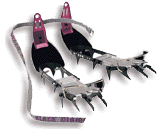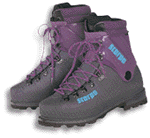Climbers' and Sherpas' Personal Gear
Sleeping gear by Slumberjack
Base Camp Tents by Eureka!
High Altitude Tents by Mountain Hardwear
Miscellaneous Gear
The Epic Grocery Store Run:
High Altitude Food From The US
Lower Camp Chow And Snacks
About $4,000 worth of salami, jerkey, sausage, pretzels, candy bars, cereal, granola, pop tarts, Red Vines, chips, salsa, crackers, mixed nuts, raisins, hard candy, cookies, maple syrup, pancake mix, tons of cough drops, hot chocolate mix, coffee, creamer, tea, antacids, gummy worms, cheese spread, powdered drink mix, dried fruit, smoked clams, sardines, deviled ham, paperback books and magazines, SPAM, squeeze margarine, cheese, mustard, ketsup, mayo, spaghetti sauce and pasta, tobasco sauce, soup mix.
Also, a lot of fresh and staple food will be purchased by the Sherpa cooks in Kathmandu, including cheese, eggs, vegetables, meats, condiments, spices, oils, flour, baking soda, lentils, rice, potatos. They'll also buy Puja supplies, which include rice meal, juniper, prayer flags, and assorted celebratory beverages.
 Crampons
Crampons Ice Ax
Ice Ax Fixed Rope
Fixed Rope Jumar
Jumar Plastic Boots
Plastic Boots None, however, have performed like ABC's Everest Boots. Last year, Beck Weathers, and this year, Hugo Rogriguez, both spent an emergency night on upper Everest without bivy gear, and neither suffered frostbite on their feet. Both were wearing ABC's Everest boots.
None, however, have performed like ABC's Everest Boots. Last year, Beck Weathers, and this year, Hugo Rogriguez, both spent an emergency night on upper Everest without bivy gear, and neither suffered frostbite on their feet. Both were wearing ABC's Everest boots.
Picket
Length of aluminum or other light-weight metal T-bar that is
driven into the snow and used as an anchor for fixed ropes or to
otherwise protect climbers.